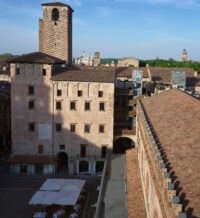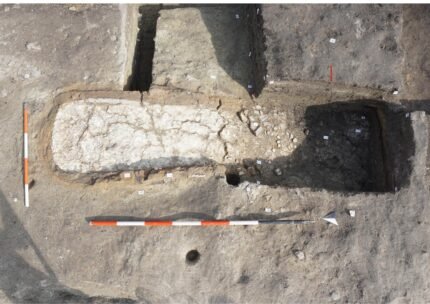A bronze bust of the Roman emperor Caligula that is small in size but large in historical significance has been rediscovered 200 years after it fell into obscurity. Dr. Silvia Davoli, curator at Strawberry Hill House, the stately home in Twickenham built by author and MP Horace Mann, identified the bust in the Schroder Collection and it was authenticated by metal experts and scholars of Roman art.
Just five inches high, the bust is one of only eight surviving small-scale busts made during the reign of Caligula (37-41 A.D.) intended for display in home shrines alongside ancestral portraits and the household deities. After Caligula was assassinated by his own Praetorian Guard, his uncle and successor Claudius had many of his statues removed or altered to look like more palatable members of the Julio-Claudian dynasty, namely Augustus or himself. With Caligula very much out of favor, people who had the personal busts got rid of them. A few have been found in the Tiber where they were unceremoniously tossed.
 This one outlasted all of the Julio-Claudians only to be buried when the eruption of Vesuvius in 79 A.D. covered the city of Herculaneum in 60 feet of volcanic mud that hardened to stone. It saw the light of day again 1630 years later when Emmanuel Maurice de Lorraine, the Prince d’Elboeuf, a French nobleman and general of the Holy Roman Emperor’s cavalry in Naples, got a tip from a local farmer that he’d discovered some fine marbles while digging a well. Between 1709 and 1711, d’Elboeuf was the first to “excavate” Herculaneum, in the sense that he tunneled down through 60 feet of volcanic stone to pillage marbles, mosaics, statues and anything else he could find to decorate the new palace he was building in nearby Portici. (It turns out he was plundering Herculaneum’s theater, although that wasn’t known until the King of Naples took his turn plundering it in 1738.) The tiny bust of Caligula was apparently one of the first objects he found.
This one outlasted all of the Julio-Claudians only to be buried when the eruption of Vesuvius in 79 A.D. covered the city of Herculaneum in 60 feet of volcanic mud that hardened to stone. It saw the light of day again 1630 years later when Emmanuel Maurice de Lorraine, the Prince d’Elboeuf, a French nobleman and general of the Holy Roman Emperor’s cavalry in Naples, got a tip from a local farmer that he’d discovered some fine marbles while digging a well. Between 1709 and 1711, d’Elboeuf was the first to “excavate” Herculaneum, in the sense that he tunneled down through 60 feet of volcanic stone to pillage marbles, mosaics, statues and anything else he could find to decorate the new palace he was building in nearby Portici. (It turns out he was plundering Herculaneum’s theater, although that wasn’t known until the King of Naples took his turn plundering it in 1738.) The tiny bust of Caligula was apparently one of the first objects he found.
 It was correspondence between D’Elboeuf, Horace Walpole and Horace Mann, the British envoy to Florence, that was the first reference Dr. Silvia Davoli found to the tiny portrait bust of Caligula. Mann got it from D’Elboeuf and sent it to Walpole in May of 1767, one of a number of antiquities Mann secured for Walpole’s collection at Strawberry Hill House. Mann was obsessed with the bust. He wrote in a letter to Mann:
It was correspondence between D’Elboeuf, Horace Walpole and Horace Mann, the British envoy to Florence, that was the first reference Dr. Silvia Davoli found to the tiny portrait bust of Caligula. Mann got it from D’Elboeuf and sent it to Walpole in May of 1767, one of a number of antiquities Mann secured for Walpole’s collection at Strawberry Hill House. Mann was obsessed with the bust. He wrote in a letter to Mann:
“I gaze on it from morning to night. It is more a portrait than any picture I ever saw. The hair and ears seem neglected, to heighten the expression of the eyes, which are absolutely divine, and have a wild melancholy in them, that one forebodes might ripen to madness.” (Walpole Correspondence, 30 May 1767)
Its eyes are extraordinary, their original inlaid silver still in place instead of the empty sockets that are usually seen in bronzes.
Walpole’s collection was more documented than most other 18th century collections. He commissioned artist John Carter to make drawings of the objects in Strawberry Hill House, including a life-sized drawing of the Caligula bust. Carter’s drawing was the second reference to the bust Davoli found.
Walpole kept his beloved Caligula bust for the rest of his life. After his death in 1797, it was passed to various family members, eventually being sold to a private collector. In the 1890s, it was purchased by Sir John Henry Schroder. By then its identity was long lost and it was catalogued in the Schroder Collection as the 15th century bust of a young man.
As curator of Strawberry Hill House, Davoli has been researching the Walpole collection for years, looking in institutions and private collections for dispersed objects mentioned in inventories, correspondence and Carter’s drawings. The Caligula bust was one of the most sought-after pieces, but despite her meticulous research tracking the lost treasure, in the end she found it by accident.
Late last year Davoli was perusing the Schroder Collection inventory for an exhibition at Strawberry Hill on treasure hunting. “By chance, I saw this page with what looked like Walpole’s bronze. Wow!” The bust was taken to Rupert Harris, the London metal conservator specialist, who said the bronze composition tallied with 2,000-year-old objects.
In the past fortnight, Dr Dietrich Boschung, an expert on imperial Roman iconography, has been shown photos of the bust. “I’m convinced it is Caligula,” says Boschung, from the Institute of Archaeology at the University of Cologne. He points to silver inserted into the eyes of the bust – a practice common for emperors. Boschung also believes the Herculaneum connection is very plausible. “Around that time, many Roman bronzes were found there.”
The rediscovered emperor will now return to Strawberry Hill House on long-term loan, It will go on public display for the first time in the new exhibition, The Art of Treasure Hunting, which opens on June 29th.


 Anal Beads
Anal Beads Anal Vibrators
Anal Vibrators Butt Plugs
Butt Plugs Prostate Massagers
Prostate Massagers
 Alien Dildos
Alien Dildos Realistic Dildos
Realistic Dildos
 Kegel Exercisers & Balls
Kegel Exercisers & Balls Classic Vibrating Eggs
Classic Vibrating Eggs Remote Vibrating Eggs
Remote Vibrating Eggs Vibrating Bullets
Vibrating Bullets
 Bullet Vibrators
Bullet Vibrators Classic Vibrators
Classic Vibrators Clitoral Vibrators
Clitoral Vibrators G-Spot Vibrators
G-Spot Vibrators Massage Wand Vibrators
Massage Wand Vibrators Rabbit Vibrators
Rabbit Vibrators Remote Vibrators
Remote Vibrators
 Pocket Stroker & Pussy Masturbators
Pocket Stroker & Pussy Masturbators Vibrating Masturbators
Vibrating Masturbators
 Cock Rings
Cock Rings Penis Pumps
Penis Pumps
 Wearable Vibrators
Wearable Vibrators Blindfolds, Masks & Gags
Blindfolds, Masks & Gags Bondage Kits
Bondage Kits Bondage Wear & Fetish Clothing
Bondage Wear & Fetish Clothing Restraints & Handcuffs
Restraints & Handcuffs Sex Swings
Sex Swings Ticklers, Paddles & Whips
Ticklers, Paddles & Whips




















